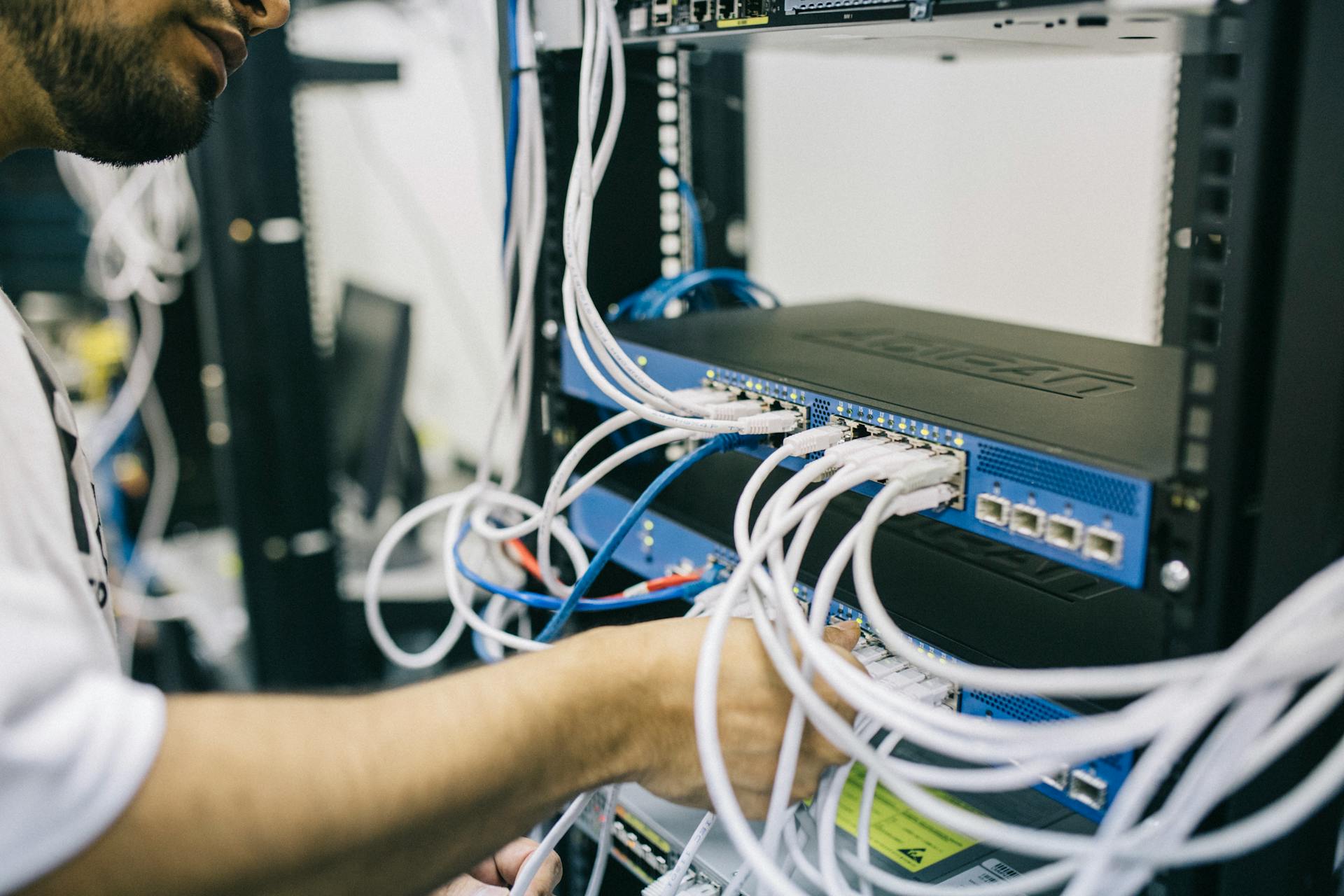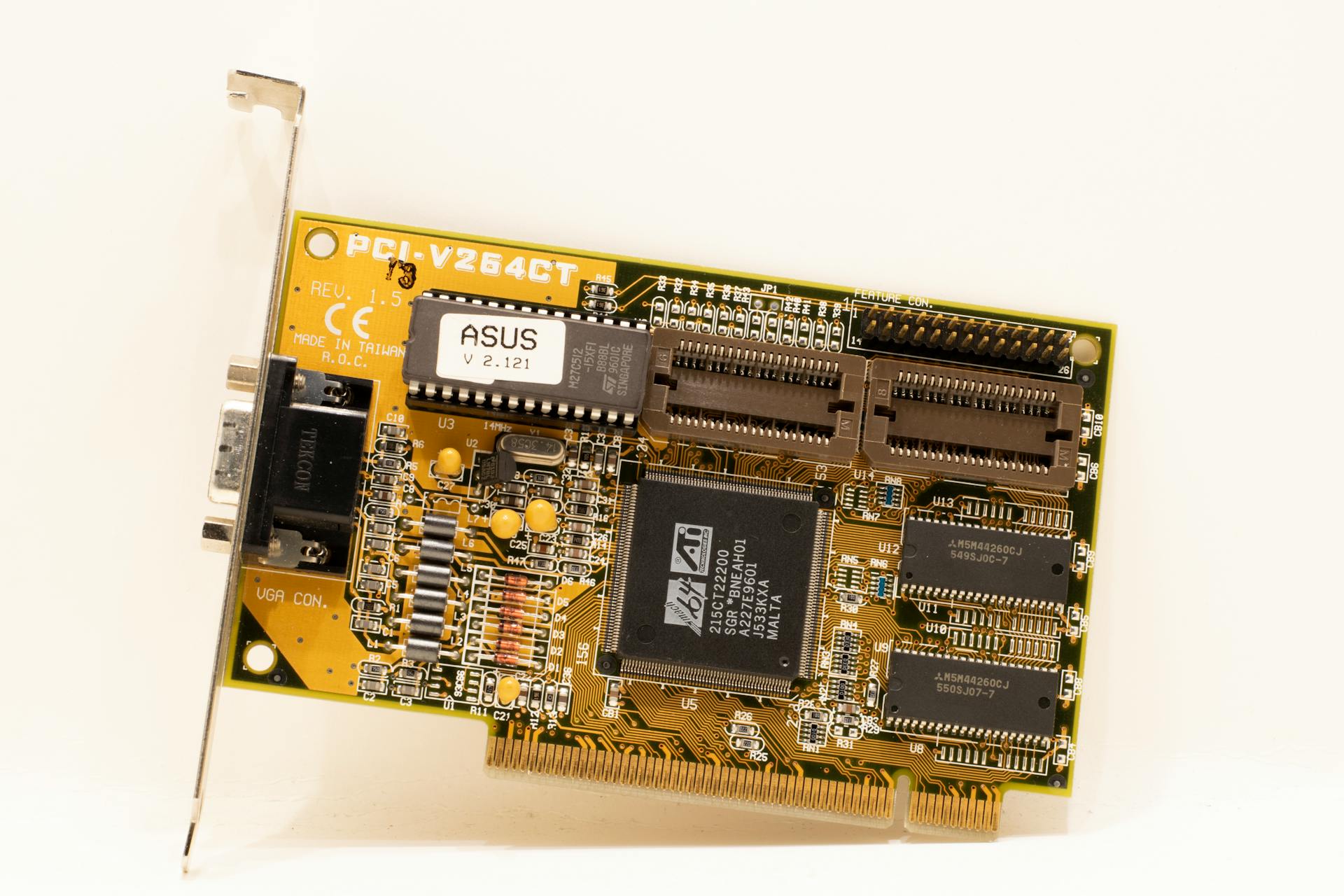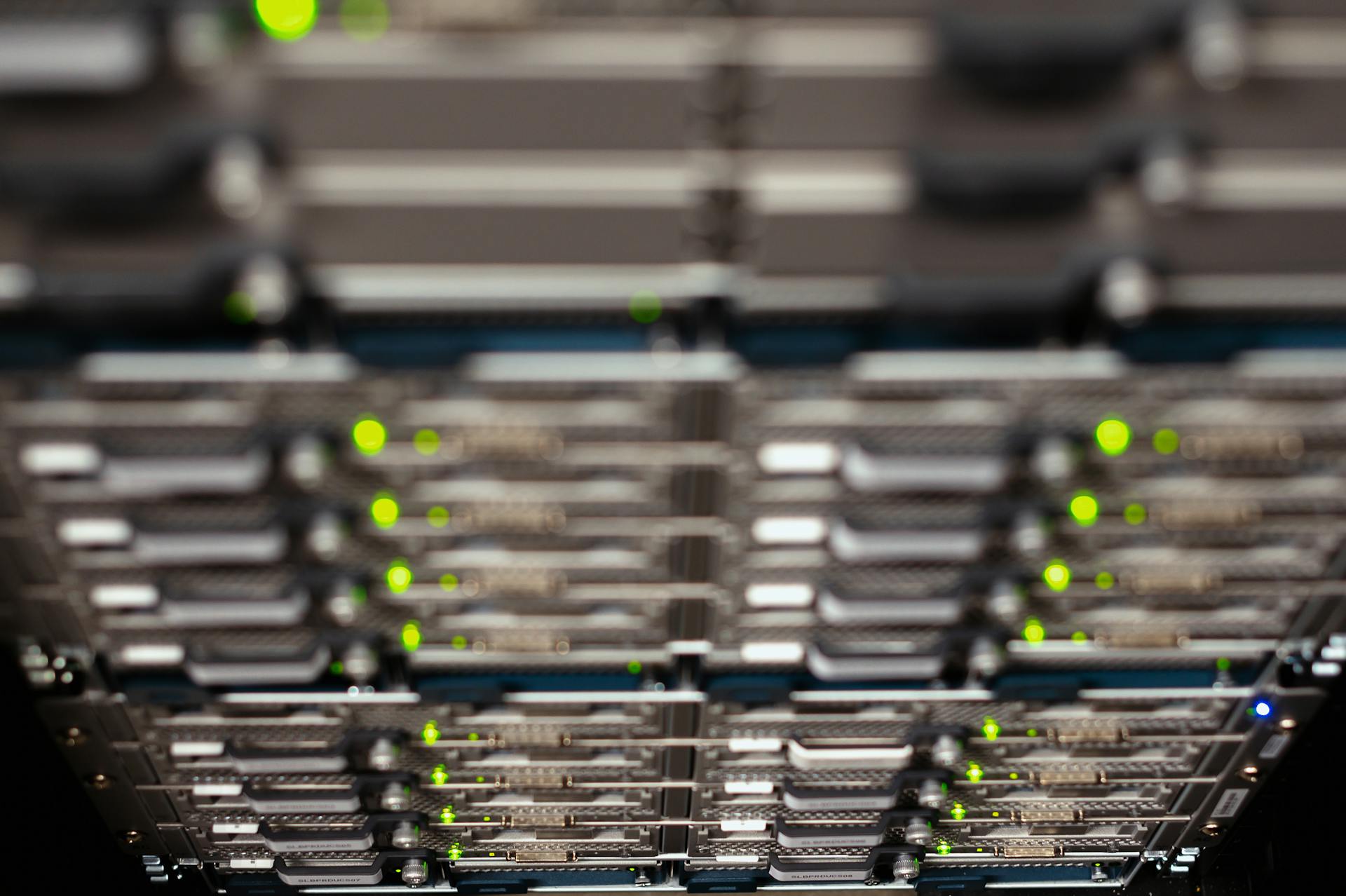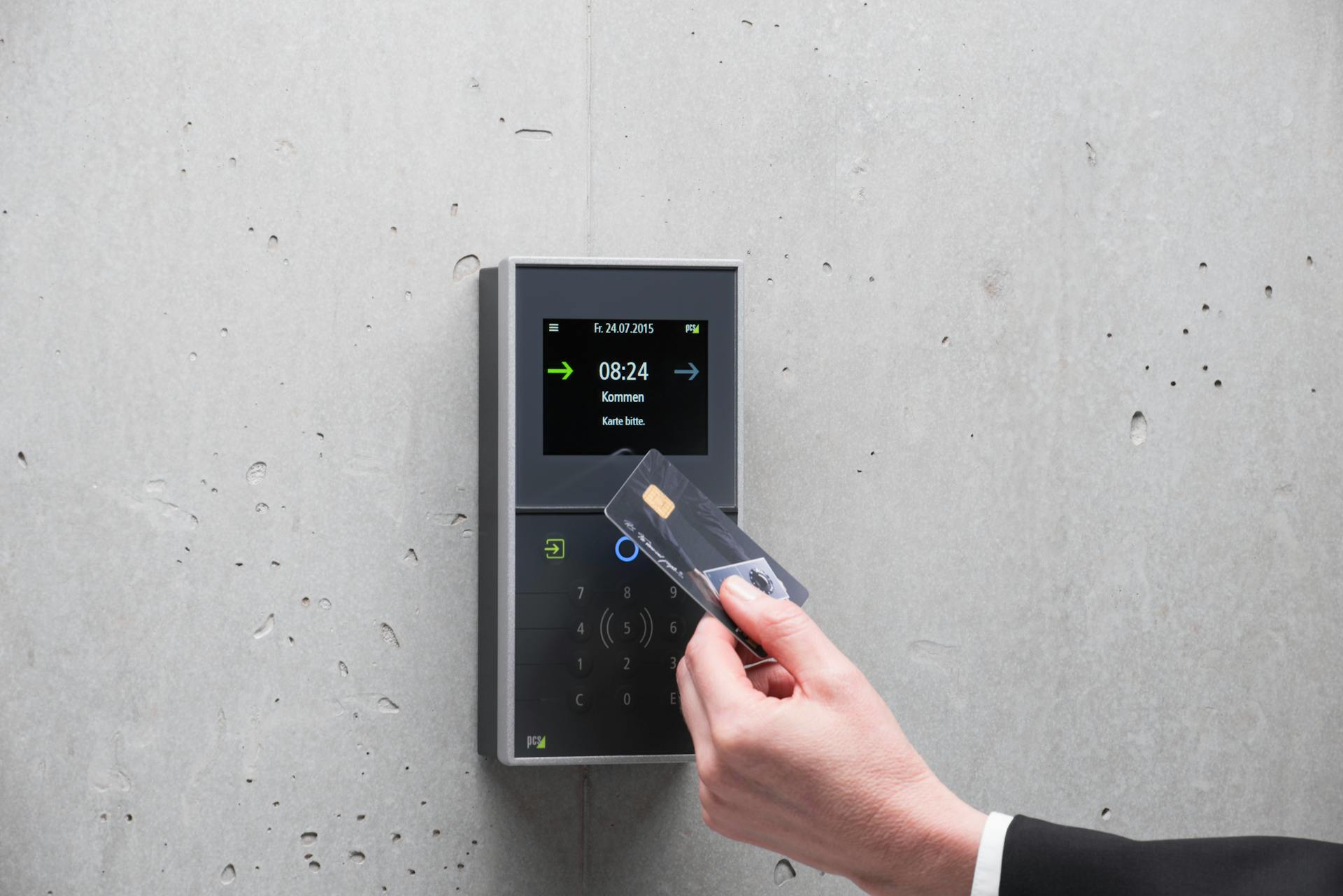
PCI compliance is a set of standards that ensures the secure handling of credit card information. It's a must-have for any business that processes, stores, or transmits credit card data.
The Payment Card Industry Data Security Standard (PCI DSS) is the governing body behind PCI compliance. It's a set of 12 requirements that must be met to achieve PCI compliance.
To achieve PCI compliance, businesses must implement a range of security measures, including firewalls, intrusion detection systems, and encryption. This helps to protect sensitive information from unauthorized access.
A unique perspective: Pci Compliant Credit Card Authorization Form
What Is PCI Compliant?
PCI compliant means that any company or organization that accepts, transmits, or stores the private data of cardholders is compliant with the various security measures outlined by the PCI Security Standard Council to ensure that the data is kept safe and private.
To achieve PCI compliance, merchants and businesses must follow 12 major security steps, including implementing firewalls, using antivirus and anti-malware software, and encrypting transmitted cardholder data.

These steps are outlined in the PCI DSS, which was recently updated to version 4.0 in March 2022. The six objectives and 12 requirements of the PCI DSS provide a clear roadmap for credit card processors to follow.
The PCI DSS scoping process determines which system components and networks are in scope for PCI DSS compliance. This is an important step, as it helps businesses identify which areas of their operations need to be secured.
A PCI compliant company must also conduct regular security assessments, which involve examining the compliance of system components in scope following the testing procedures for each PCI DSS requirement. This helps ensure that their security measures are up to date and effective.
Here are the 12 major steps to achieve PCI compliance:
- Implement firewalls to protect data
- Appropriate password protection (such as 2FA)
- Protect cardholder data
- Encryption of transmitted cardholder data
- Utilize antivirus and anti-malware software
- Update software and maintain security systems on a regular basis
- Restrict access to cardholder data
- Unique IDs assigned to those with access to data
- Restrict physical access to data storage
- Create and monitor access logs
- Test security systems on a regular basis
- Create a policy that is documented, and that can be followed
Benefits and Requirements
Becoming PCI compliant is a great way to protect your customers' sensitive payment card information and build trust with your business. By following the 12 key requirements of PCI DSS, you can ensure that your systems are secure and compliant with industry standards.

One of the main benefits of PCI compliance is that it improves your reputation with acquirers and payment brands, which can lead to more business opportunities. By having a secure system, you're also better prepared to comply with additional regulations, such as HIPAA and SOX.
Here are the 12 key requirements of PCI DSS in brief:
- Install and Maintain a Firewall Configuration to Protect Cardholder Data
- Do Not Use Default Passwords
- Protect Stored Cardholder Data through Encryption
- Encrypt Transmission of Cardholder Data Across Open, Public Networks
- Use and Regularly Update Anti-Virus Software
- Develop and Maintain Secure Systems and Applications
- Restrict Access to Cardholder Data by Business Need-to-Know
- Assign a Unique ID to Each Person with Computer Access
- Restrict Physical Access to Cardholder Data
- Track and Monitor All Access to Network Resources and Cardholder Data
- Regularly Test Security Systems and Processes
- Maintain an Information Security Policy
By following these requirements, you can ensure that your business is PCI compliant and secure, which can lead to many benefits, including enhanced security posture, protection from data breaches, and improved reputation with customers and partners.
Benefits of PCI Compliant
Implementing PCI compliance guidelines offers a range of benefits, including enhancing overall security posture and protecting from data breaches. This is especially important for companies that process credit card information, as failure to comply can result in substantial fines for agreement violations and negligence.
PCI compliance helps build an optimized security stance and enhances operational efficiency. It also helps manage risks proactively and fosters a compliance culture.
You might like: Cyber Security Pci Compliance

Companies that are PCI compliant are better prepared to comply with additional regulations, such as HIPAA, SOX, and others. This is because the ongoing process of meeting PCI compliance requirements helps identify and address security gaps that could impact compliance with other regulations.
Regular monitoring, assessments, and audits of Payment Card Industry Data Security Standards are all an important part of a company's security department. This helps prevent security breaches and payment card data theft, contributing to a global payment card data security solution.
PCI compliance is not just a requirement, but also a way to improve reputation with acquirers and payment brands. This is crucial for businesses that rely on partnerships with these organizations to operate.
Here are some of the key benefits of PCI compliance:
- Secure systems that protect customer sensitive payment card information
- Improved reputation with acquirers and payment brands
- Prevention of security breaches and payment card data theft
- Preparation for compliance with additional regulations
- Improved IT infrastructure efficiency
Requirements for PCI Compliant
PCI compliance is a set of guidelines set forth by the PCI Standards Council, an organization formed in 2006 to manage the security of credit cards. The requirements developed by the Council are known as the Payment Card Industry Data Security Standards (PCI DSS).

The PCI DSS has 12 key requirements, 78 base requirements, and over 400 test procedures. To become PCI compliant, businesses must consistently adhere to these guidelines. PCI compliance is governed by the PCI Standards Council, and it's essential for merchants and other businesses to handle credit card information in a secure manner.
The 12 key requirements of PCI DSS are outlined in the Payment Card Industry Data Security Standards. Here's a brief overview of each requirement:
- Install and Maintain a Firewall Configuration to Protect Cardholder Data
- Do Not Use Default Passwords
- Protect Stored Cardholder Data through Encryption
- Encrypt Transmission of Cardholder Data Across Open, Public Networks
- Use and Regularly Update Anti-Virus Software
- Develop and Maintain Secure Systems and Applications
- Restrict Access to Cardholder Data by Business Need-to-Know
- Assign a Unique ID to Each Person with Computer Access
- Restrict Physical Access to Cardholder Data
- Track and Monitor All Access to Network Resources and Cardholder Data
- Regularly Test Security Systems and Processes
- Maintain an Information Security Policy
Businesses must meet these requirements to ensure the security of credit card information and prevent data breaches. The type of annual assessment required depends on a few factors, including the volume of card transactions.
A fresh viewpoint: Storing Credit Card Information Pci Compliance
Compliance Process
To become PCI compliant, you'll need to follow a series of steps. The first step is to determine your merchant level, which is based on the number of Visa transactions you process per year. For Visa, there are four levels: Level 1 for over 6 million transactions, Level 2 for 1-6 million transactions, Level 3 for 20,000-1 million e-commerce transactions, and Level 4 for fewer than 20,000 e-commerce transactions or up to 1 million total annual transactions.
You might enjoy: Pci Dss Requirement 6
You'll need to fill out a self-assessment form, unless you're a larger business that needs to hire third-party auditors. These auditors will assess your business and submit additional paperwork.
The PCI compliance process involves six objectives and 12 requirements. These requirements include implementing firewalls, using antivirus and anti-malware software, and encrypting transmitted cardholder data.
To meet the PCI requirements, you'll need to go through a series of steps, including assessment, reporting, and clarifications. Assessment involves examining the compliance of system components in scope following the testing procedures for each PCI DSS requirement.
Here are the key terms to understand in the PCI compliance process:
- PCI DSS Scoping: Determining which system components and networks are in scope for PCI DSS for your business.
- Assessment: Examining the compliance of system components in scope following the testing procedures for each PCI DSS requirement.
- Reporting: The assessor or entity submits required documentation, like the Self-Assessment Questionnaire (SAQ) or Report on Compliance (ROC), including documentation of all compensating controls.
- Clarifications: The assessor or entity clarifies or updates report statements (if applicable) upon request of the acquiring bank or payment card brand.
The most recent version of PCI DSS was released in March 2022 and is referred to as version 4.0.
Additional reading: Pci Dss Version
Security Measures
To maintain a secure environment, create a private internet connection that's password protected, and install firewalls and antivirus software on your computer network.
Firewalls are essential in blocking access of foreign or unknown entities attempting to access private data, and they're required for PCI DSS compliance. Your computer's operating system likely already has a firewall as part of its security software, but check to make sure it's operating properly.
Regularly patch and update your anti-virus software, and consider using multi-factor authentication (MFA) to restrict access to confidential payment data to select trustworthy users.
Additional reading: Hipaa Compliant Accounting Software
Firewall Use and Maintenance

Firewalls are a crucial part of your computer's security software, and they're often the first line of defense against hackers.
You can find a firewall as part of your computer's operating system, but it's essential to check if it's operating properly to ensure your data is secure.
Installing firewalls on your computers and internal network is a must, and it's a requirement for PCI DSS compliance due to their effectiveness in preventing unauthorized access.
Firewalls block access of foreign or unknown entities attempting to access private data, making them a vital security measure.
A private internet connection that's password protected is also a must-have, and it's recommended to use antivirus software on your computer network to prevent data breaches.
Encrypt Transmitted Data
Encrypting transmitted data is a must when handling cardholder information. This means that any data sent to payment processors, home offices, or other locations must be encrypted.
You should never send account numbers to unknown locations, as this can put sensitive information at risk. This is a basic security measure that can help prevent data breaches.
On a similar theme: First Data Pci Compliance

Encryption is a powerful tool that can scramble data so it can't be viewed by just anyone. The PCI SSC recommends using cryptography and security protocols like TLS, SSH, or IPSec to protect cardholder information.
In practice, this means that you should use credit card terminals and PIN pads that are current and compliant with PCI Data Security Standard (DSS). This will help ensure that your systems are secure and up to date.
Vulnerability Scan
Vulnerability scans are a crucial security measure that helps identify potential weaknesses in your network and operating systems. They're an essential part of maintaining PCI compliance standards.
You should perform internal and external vulnerability scans at least quarterly, and always after any major network change. A qualified professional must complete the scan, and afterward, any detected vulnerabilities must be addressed.
Regular vulnerability scans can help limit the threats that can arise from software malfunctions, outdated products, and human error. These scans use a variety of measures, including patch management and configuration management, to help protect data and detect weaknesses.

Penetration testing, on the other hand, must be performed annually. It determines how malicious actors could gain access to valuable information and security assets, and it's essential for identifying vulnerabilities that might not be caught by regular scans.
After scanning and testing, it's essential to remediate any identified vulnerabilities immediately. This is because the nature of taking card payments is highly sensitive, and any issues must be handled right away to protect cardholder data.
Access Control
Access Control is crucial in maintaining PCI compliance. Restricting access to sensitive data is a must, with cardholder data being strictly "need to know." All staff, executives, and third parties who don't need access should not have it.
Having unique IDs for access is also essential. Individuals who do have access to cardholder data should have individual credentials and identification for access, not a single login with multiple employees knowing the username and password.
Physical access to cardholder data must be restricted. Any sensitive data must be physically kept in a secure location, such as a locked room, drawer, or cabinet. Access should be limited, and anytime the sensitive data is accessed, it should be kept in a log.

Access logs are a must-have for PCI compliance. All activity dealing with cardholder data and primary account numbers (PAN) require a log entry. This includes documenting how data flows into your organization and the number of times access is needed.
Using access control measures is vital. Restrict access to any confidential payment data to select trustworthy users. This includes using authentication methods like multi-factor authentication (MFA), unique usernames and passwords, pins, and security tokens to minimize the risk of a breach or unauthorized login.
Proper password protections are also essential. This includes keeping a list of all devices and software that require a password, and changing the password on routers, modems, point of sale (POS) secure systems, and other third-party products.
Explore further: Pci Dss Password Requirements
Monitoring and Maintenance
Monitoring and Maintenance is a crucial aspect of maintaining PCI compliance. Firewalls are essential in blocking access of foreign or unknown entities attempting to access private data.
Having a firewall in place is required for PCI DSS compliance. It's the first line of defense against hackers, making it a must-have for any organization handling card data.
Continuous monitoring is necessary to ensure data security and compliance. This involves mapping internal controls to PCI DSS goals and protecting points where card data enters, gets stored, and exits the organization.
Automating monitoring and assessment processes can save time and reduce costs. At Sprinto, they automate the monitoring and assessment process to ensure visibility and remain PCI compliant throughout the year.
Regular checks can be triggered to ensure compliance, such as verifying password requirements. This helps fix patches that need fixing when patches show up, ensuring data security.
A secure network is also essential in preventing data breaches. This includes installing firewalls, antivirus software, and using a private internet connection that's password protected.
Expand your knowledge: Pci Dss Risk Assessment
Policies and Procedures
Documenting your policies is a crucial step in becoming PCI compliant. You'll need to document inventory of equipment, software, and employees with access to cardholder data, as well as logs of accessing cardholder data.
Inventory includes equipment, software, and employees with access, which all need to be accounted for in your documentation. This includes how information flows into your company, where it is stored, and how it is used after the point of sale.
Mapping your policies and controls to the PCI framework is also essential. This involves identifying and eliminating out-of-scope items, and automating the PCI compliance process can make this task much more manageable.
Document Policies
Documenting your policies is a crucial step in maintaining compliance. This includes creating an inventory of equipment, software, and employees who have access to sensitive information, such as cardholder data.
To ensure you're documenting everything correctly, you'll need to log all instances of accessing cardholder data. This will help you track how information flows into your company, where it's stored, and how it's used after the point of sale.
Creating a detailed information security policy is also essential. This policy should outline the steps you'll take to maintain compliance with PCI standards, and it should be regularly reviewed and updated to ensure it remains effective.
Remember, documenting your policies is not a one-time task - it's an ongoing process that requires regular maintenance and updates.
What Happens When You're Absent
Being absent from following policies and procedures can have serious consequences. The cost of non-compliance can range from $5,000 to $100,000, depending on the nature of the non-compliance.
Your business's reputation can take a hit, with each non-compliance instance flagged as a security violation. This can lead to significant reputational damage.
Non-compliance can also result in the loss of access to promote card-based technology transactions on your business platforms.
You might enjoy: Pci Compliance for Small Businesses
Penalties for Non-Compliance
Non-compliance with PCI standards can have severe consequences. Fines for ignoring PCI compliance requirements can reach up to $100,000 per month.
You could be removed from the credit card processing network, effectively shutting down your business's ability to process credit card transactions. This can be devastating for businesses that rely on credit card sales.
Non-compliance fines can cost up to $500,000 per PCI data security incident or breach. All individuals whose information is believed to have been compromised must be notified in writing to be on alert for fraudulent charges.
Banks and payment companies may choose not to do business with you unless you are PCI-compliant. This can result in lost sales and a tarnished brand image.
Explore further: Pci Non Compliance Fee
Frequently Asked Questions
What does PCI stand for?
PCI stands for Payment Card Industry, a set of security standards for entities involved in payment card processing. Learn more about the PCI Data Security Standards and how they impact your business.
Is PCI compliance required by law?
PCI compliance is not legally required by law in the US, but credit card companies may impose fines or restrictions on non-compliant businesses.
What are the 4 levels of PCI compliance?
There are four levels of PCI compliance, categorized by the number of annual transactions processed: Level 1 (over 6 million), Level 2 (1-6 million), Level 3 (20,000-1 million), and Level 4 (less than 20,000). Understanding your business's level is crucial for meeting PCI security standards.
Which cards require compliance with PCI?
Debit and credit cards require compliance with PCI DSS for secure processing and storage of cardholder data
Is the last 4 digits of a credit card PCI compliant?
Yes, storing only the last 4 digits of a credit card is considered PCI compliant. However, note that storing the first 6 digits is also allowed under PCI guidelines.
Featured Images: pexels.com


